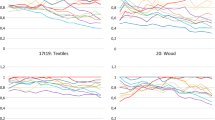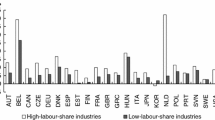Abstract
How technical progress affects economic growth has been one of the fundamental themes of the research of Ryuzo Sato (e.g. Sato and Ramachandran, 1999). This paper and the papers it summarizes are part of that tradition, in that we focus on how technical progress drives factor productivity and how that in turns increases welfare in dynamic models.
Research support was provided by the World Bank under RPO No. 68140, “The Dynamic Impact of Trade Liberalization in Developing Countries.” The views expressed are those of the authors alone and should not be interpreted as the opinion of the World Bank.
Access this chapter
Tax calculation will be finalised at checkout
Purchases are for personal use only
Preview
Unable to display preview. Download preview PDF.
Similar content being viewed by others
References
Bhagwati, Jagdish and T.N. Srinivasan (1999), “Outward-Orientation and Development: Are Revisionists Right?” Yale University Economic Growth Center Working Paper No. 806, September. Available at: http://www.library.yale.edu/socsci/egcdis2.html
Connolly, Michelle (1999), “North-South Technological Diffusion: A New Case for Dynamic Gains from Trade,” Duke University Economics Dept. Working Paper No. 99-08 (http://www.econ.duke.edu).
Frankel, Jeffrey and David Romer (1999), “Does Trade Cause Growth,” American Economic Review, 89(3), 379–399.
Harris, Richard (1984), “Applied General Equilibrium Analysis of Small Open Economies with Scale Economies and Imperfect Competition,” American Economic Review, 74(5), December, 1016–1032.
Harrison, G.W., T.F. Rutherford, and D.G. Tarr (1993), “Trade Reform in the Partially Liberalized Economy of Turkey,” The World Bank Economic Review, 7(2), 191–217.
Harrison, G.W., T.F. Rutherford, and D.G. Tarr (1996), “Increased Competition and Completion of the Market in the European Union,” Journal of Economic Integration, 11(3), 332–365.
Harrison, G.W., T.F. Rutherford, and D.G. Tarr (1997a), “Quantifying the Uruguay Round,” Economic Journal, 107, September, 1405–1430.
Harrison, G.W., T.F. Rutherford, and D.G. Tarr (1997b), “Economic Implications for Turkey of a Customs Union With the European Union,” European Economic Review, 41, 861–870.
Krueger, Anne (1997), “Trade Policy and Economic Development: How do we Learn,” American Economic Review, vol. 87(1), 1–22.
Lopez de Silanes, Florencio, James R. Markusen and Thomas F. Rutherford (1994), “Complementarity and increasing returns in intermediate inputs,” Journal of Development Economics, 45:133–151, 1994.
Melo, J. de and D. Tarr (1992), A General Equilibrium Analysis of US Foreign Trade Policy, Cambridge MA.: MIT Press.
Melo, J. de and D. Tarr (1990), “Welfare Costs of U.S. Quotas in Textiles, Steel and Autos,” Review of Economics and Statistics, 72(3), 489–497.
Melo, J. de and D. Tarr (1993), “Industrial Policy in the Presence of Wage Distortions: The Case of the US Auto and Steel Industries,” International Economic Review, 34(4), 833–851.
Morkre, Morris and David G. Tarr (1980), Effects of Restrictions on United States Imports: Five Case Studies and Theory, Washington, D.C.: Federal Trade Commission.
Rodriguez, Francisco and Dani Rodrik (1999), “Trade Policy and Economic Growth: A Skeptic’s Guide to the Cross-National Evidence,” NBER Working Paper No. W7081, April.
Rodrik, Dani (1992), “The Limits of Trade Policy Reform in Developing Countries,” Journal of Economic Perspectives, 6(1), Winter, 87–105.
Romer, P. (1994), “New Goods, Old Theory and the Welfare Costs of Trade Restrictions,” Journal of Development Economics,” 43(1), February, 5–38.
Rutherford, Thomas (1995), “Extensions of GAMS for complementarity problems arising in applied economics”, Journal of Economic Dynamics and Control, December, 1299–1324.
Rutherford, Thomas F. and David G. Tarr (2000), “Trade Liberalization, Product Variety and Growth in a Small Open Economy,” mimeo, Washington D.C.: The World Bank. Earlier version available as World Bank Policy and Research Working Paper Number 1970, from website: http://www.worldbank.org/research/trade/research/trade
Rutherford, Thomas F. and David G. Tarr (2000a), “Regional Trading Agreements: The Implications for Chilean Economic Growth,” mimeo, Washington D.C.: The World Bank.
Rutherford, Thomas F. and David G. Tarr (1998), “Regional Trading Arrangements for Chile: Do the Results Differ with a Dynamic Model?” Paper presented at the Allied Social Science Meetings, New Orleans, La., The World Bank, mimeo.
Sachs, J.D. and A. Warner (1995), “Economic Reform and the Process of Global Integration,” Brookings Papers on Economic Activity, W.C. Brainard and G.L. Perry (eds.), Washington, D.C., 1–117.
Sato, Ryuzo and Rama Ramachandran (1999), The Selected Essays of Ryuzo Sato, Volume 1: Growth Theory and Technical Change, Economists of the Twentieth Century series, Cheltenham, U.K. and Lyme, N.H.: Elgar.
Tarr, D.G. and M. Morkre (1984), Aggregate Costs to the United States of Tariffs and Quotas on Imports, Washington, D.C.: Federal Trade Commission.
World Bank (1987), World Development Report. New York: Oxford University Press.
Author information
Authors and Affiliations
Editor information
Editors and Affiliations
Rights and permissions
Copyright information
© 2001 Springer Science+Business Media New York
About this chapter
Cite this chapter
Rutherford, T.F., Tarr, D.G. (2001). The Dynamic Gains from Trade Liberalization with Product Variety: Summary of Results. In: Negishi, T., Ramachandran, R.V., Mino, K. (eds) Economic Theory, Dynamics and Markets. Research Monographs in Japan-U.S. Business & Economics, vol 5. Springer, Boston, MA. https://doi.org/10.1007/978-1-4615-1677-4_17
Download citation
DOI: https://doi.org/10.1007/978-1-4615-1677-4_17
Publisher Name: Springer, Boston, MA
Print ISBN: 978-1-4613-5673-8
Online ISBN: 978-1-4615-1677-4
eBook Packages: Springer Book Archive




